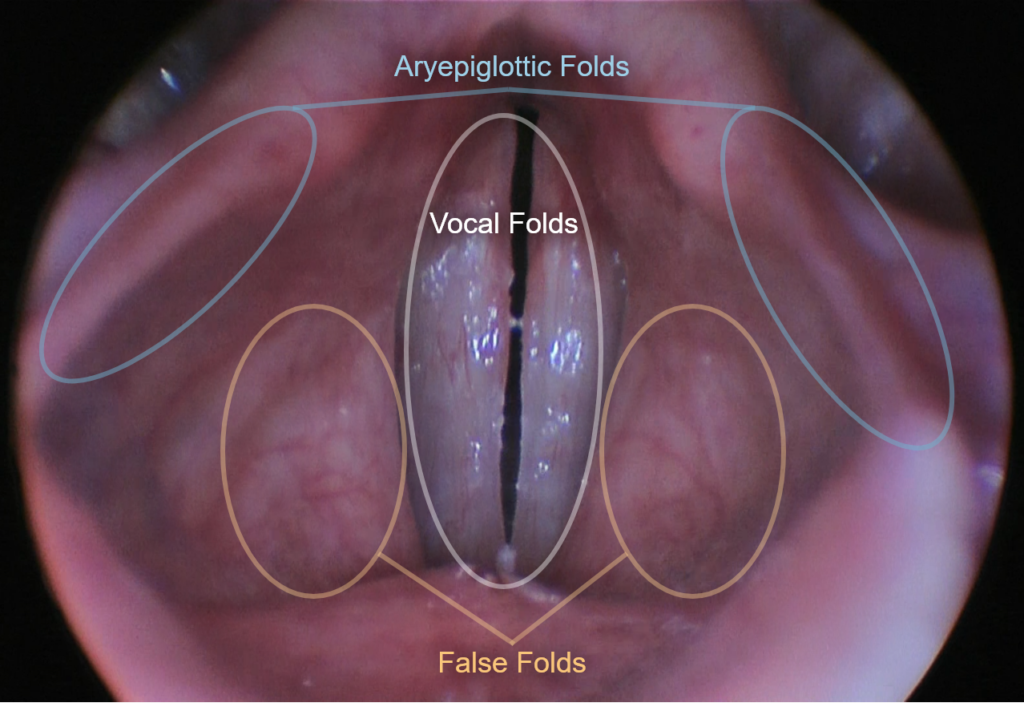Let the bodies hit the floor!
Today is your 10-cent tour of the art and anatomy of screaming. I’m gonna get specific about what these visceral sounds are, how our bodies create them, and how they can be a healthy addition to your toolbox. In order to properly explain such an extreme vocal technique, we need to have a quick recap of some basics!
What exactly is the voice?
Our voice- either speaking or singing- is created through a team effort. The star of the show is our vocal folds- two narrow blobs of tissue that vibrate together when air passes through them, creating soundwaves. The vocal folds need a lot of backstage support from our lungs, diaphragm, and abdomen to do their job though. They need just the right amount of air to create those vibrations clearly without getting worn out! And we can’t forget about the sound design team: our throat, nasal cavity, oral cavity, tongue, teeth and lips. These folks take the little vibrations our breath and vocal folds make and turn them into words and sounds. This team allows us to turn vibrations into communication.
So how does screaming belong in our voices?
The profile of sound waves our voice normally creates when we speak or sing is really different from how Jared Leto sounds at a 30 Seconds to Mars concert. So, what gives? To start, you should know the more accurate term for what we’re talking about is actually vocal distortion. There are many ways our body can create vocal distortion, and today you’ll learn a couple of the most common.
Almost all vocal distortion is created in one of two ways, or some combination of the two:
1. Tissues in our throat (NOT our vocal folds) vibrate chaotically
2. Our vocal folds vibrate in an atypical way.
There are both healthy and unhealthy ways to make these two things happen, and today you’ll learn about three ways that can be done while maintaining vocal health – False Fold, Aryepiglottic, and Fry screaming.

False Fold Screaming
Their technical name is the vestibular folds. They are two folds of soft tissue that cover ligaments in our larynx. They’re positioned just above our vocal folds, and run parallel to them. Our vestibular folds are THICC. They help protect our airway and keep our vocal folds lubricated. They’re casually called false folds or false cords because they look like part of our vocal folds at first glance.
Our false folds don’t vibrate together by default. They usually keep a comfortable distance from each other and focus on protecting their respective vocal fold chilling underneath them. False Fold Screaming gives them a special assignment and gets them working together to create erratic vibrations. By opening our vocal folds wide (and not using them) to let a bunch of air through our throat, we can get the false folds slapping together to create primordial screams (cue screamo music). Because the false folds are so thick and unwieldy, these screams create a lot of noise. They’re usually loud, and they lack a clear note or pitch, making them a pitch-less scream.
A great benefit of false fold screaming is that it can be a very safe way to start learning vocal distortion. Because our true vocal folds naturally abduct- or separate from each other- when we do a false fold scream properly, they won’t get in the way and get damaged as we take our first steps toward rock stardom. It is possible to engage our vocal folds and sing at the same time that we perform a false fold scream, but it’s difficult to do and I don’t recommend it for beginners as it can increase the risk of injury when you don’t know what you’re doing. Starting out, commit to a nice growly, demonic, pitch-less scream and it will keep your vocal folds safely tucked away in their beds while you experiment. Maybe warn your roommates first.
Here’s a great demonstration of a false fold scream during a laryngoscopy so you can see how the tissues in your vocal tract would behave: https://youtu.be/T3jRE2SPv-w?t=17
Aryepiglottic Screaming
Ary-what? Let me explain.
If you haven’t met your epiglottis, it’s a large, Pringle chip shaped piece of cartilage that sits just behind your tongue and it moves around when you speak and sing. Notably, your epiglottis moves back into your throat when you swallow to protect your airway. Well connected to both the left and right sides of your epiglottis are folds of soft tissue called the aryepiglottic folds. Yep- we’re back to folds, hooray!
Aryepiglottic screaming is distortion created by pulling the epiglottis back just a bit, which allows the aryepiglottic folds to become slack so they can flap in the wind. With the proper amount of airflow, these folds will vibrate to create a nice, juicy growl (cue Christina Aguilera).
Aryepiglottic vibrations by themselves lack a clear pitch, but are almost always paired with regular singing. They’re used as a filter of distortion on top of our clean singing to create some soaring pitched screams. A singer who does this really well, and uses it in a lot of vocals is Sam Carter of the band Architects. What’s great about aryepiglottic distortion is that it can be used as a seasoning, a side dish, or the whole meal! You can create just a little to add angst to a chorus, a bigger chunk of it to start a line off with a growl, or you can go to the dark side and use it in your entire song (you know you want to.)
In the video example linked under False Fold Screaming, the singer is not only vibrating their false folds, but also often their aryepiglottic folds at the same time (especially the ary fold on their right!) You can see the aryepiglottic folds vibrate on the scream at this time stamp: https://youtu.be/T3jRE2SPv-w?t=31
Fry Screaming
Not to be confused with “vocal fry”- the slow croaky sound your voice makes below your lowest notes. Fry Screaming is a sizzle-y, creaky scream that sets itself apart from False Fold and Aryepiglottic screams because the distortion is created by our true vocal folds and not other tissue in our throat. By finding complete adduction – or closure – of our vocal folds at a proper tension, and then pushing a small amount of air through them, our folds vibrate atypically to create a creaky sizzle. This scream is pretty quiet compared to the other two, but the sound can be amplified using our throat, nasal passage and mouth to create a raspy, scratchy scream that has a pretty gnarly sound. You’ll still want a mic to make the most of it though!
At this point I’m going to make a disclaimer. Of the three screams I’m describing I know the least about this one. Also, Fry Screaming manipulates the vocal folds directly and gets them vibrating in an uneven way, so theoretically it could increase risk of injuring the vocal folds. For example, if we muscle our vocal folds shut with too much force, and then force our air through them anyway to get the scream out, we could develop a vocal nodule or polyp over time. Disclaimer out of the way, I believe with careful training and a vocal health regimen this scream can be used safely just like the other techniques. There are professional singers who use and have used it in their music and have had lengthy, successful careers. Oli Sykes is a great example. Here’s a clip of him using fry scream during his performance with Ed Sheeran at the BRIT awards: https://youtu.be/HuzlYAMwwJY?t=230. Chester Bennington used fry scream a lot (despite the fact he often sang with excess muscle tension). Here’s an example of Chester doing a fry scream at a live performance: https://youtu.be/OZW6bJ_4yag?t=119
And here’s an example of fry scream during a laryngoscopy: https://youtu.be/T3jRE2SPv-w?t=118
Master clean singing technique before learning to scream
Even for professionals who do it every day, screaming is an extreme vocal technique! It can wear on our voices, and lead to injuries. This shouldn’t scare singers away from it though. Clean singing, and even speaking can cause vocal injuries. Singing in any form is an athletic act that deals with delicate tissues throughout our body. However clean singing is generally gentler on our bodies, and there is a greater wealth of knowledge on the subject. The risk of injury seems to be lower, and learning to sing clean will make learning to scream SO much easier.
The most important ingredients for screaming are lots of breath support, breath control, and body awareness- especially of our throat and mouth. These ingredients are learned and woven into our muscle memory as we practice fundamental singing techniques. Clean singing is also easier to get started with as it’s much more understood by the singing community, and it’s a lot like how you already speak every day.
For experienced singers who can go through their range in a healthy mix, I encourage you to dive into the world of vocal distortions! They give you more colors to paint with, and they challenge your vocal mastery. Both Jacob and I have remarked to each other that working on screams has strengthened our mix and our ability to sustain through phrases (we think this is because of the intense adduction and breath support screaming practice requires).
Now you’re amped – what next?
Now that you’ve read what can be done, and how it can be done, you may be asking “yeah, but how can I do it?” I have done my job well and deserve a medal 🙂
The short answer to your question is find a vocal coach! I know, I know… you’d love for me to spill all the beans right now. But screaming is such an individual learning process, and instruction created for the masses is not the best way to learn it. Learning proper, healthy screaming requires guidance and oversight. There are some great YouTube videos you can watch to start trying sounds (RiffShop makes good content), but there is also a lot of bad advice on the internet and videos won’t give you feedback when you’re doing it right or wrong. So, look for a vocal coach who has good reviews, and has demonstrated knowledge of screaming AND clean singing technique. If you already have a vocal coach, ask them if they teach screaming! If they don’t, ask if they know a coach who they could refer you to for specialty lessons.
Thank you for being here today
I sincerely hope you’ve enjoyed your tour today! I pray this read gives you a greater appreciation for and interest in the art of vocal distortions. Personally, screaming has been a welcome challenge for me as a singer for many years, and it’s been exciting to see students learn it! It opens doors for greater artistic expression, and can strengthen your clean singing technique. Plus, you can create some pretty juicy looks of confusion on peoples faces, perfect for awkward family holiday dinners.
Rock on. Rock strong.


